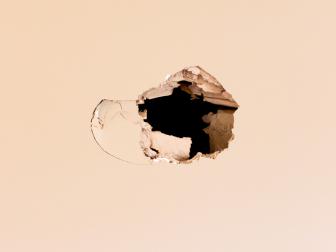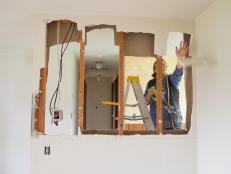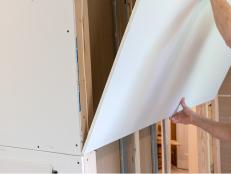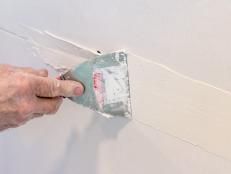How to Remove Drywall Anchors
Wall anchors can be tricky to get out of a wall. Follow these tips to reduce damage and repair unsightly holes.

Drywall anchors can support loads big and small, and they’re usually easy to install. That said, when you need to remove drywall anchors, it’s not as simple as reversing course. As handy and hardworking as wall anchors are, they’re only used when you can’t reliably target a wall stud. Its one-and-only job is to hold on with all its might, so you could just say that the best wall anchors are the hardest to remove. Whether you use drywall anchors, molly bolts or toggle bolts, once it is time to remove a wall anchor, you’ll have to learn how to minimize drywall damage and fill the holes. But never fear! With a little know-how, you can learn to do it safely without causing additional damage.

Chris Hill
Wall Anchor
There are different methods for removal and repair suited to each type of wall fastener. Depending on the anchor you’re working with, it’s important to know your options. If it seems like a losing battle, we’ll also share tips on how to recess a wall anchor for a guaranteed better finish.
How to Use Drywall Anchors, Molly Bolts and Toggle Bolts
Secure items into drywall with confidence. Learn how to choose the right wall anchor to support framed artwork, shelving, mirrors and accessories.
Pull It With Needle-Nose Pliers
Plastic or steel drywall anchors are typically cone-shaped products tapped into your drywall. Unlike molly and anchor bolts that attach to the backside of the drywall, these anchors can often be carefully pulled out with know-how and finesse.
Start by removing any screws that may still be attached to the wall anchor. Then, using needle-nose pliers to firmly grip the inside edge of the wall anchor, grab the collar or head of the drywall anchor and give it a wiggle and tug. Use judgment as you test how freely it will move within the drywall hole. It’s likely that it may wiggle slowly and gradually emerge from being flush with the drywall.
If the anchor is further embedded and seems like it won’t smoothly release from the drywall, it’s possible that tugging on it can cause more damage. If that’s the case, keep reading, because there are other options.

Chris Hill
Wall Driller Anchor
Use a Screwdriver or Drill to Back It Out
If your plastic or metal drywall anchor is tightly embedded, you can employ a screwdriver to act as a counter-screw bit. Choose a screwdriver that fits tightly into the anchor and give it an extra tap with a hammer to make sure it gets a good hold. When you apply pressure and twist the screwdriver counter-clockwise, you can sometimes “unscrew” the drywall anchor out far enough so you can grip the edge with needle-nose pliers.
If you're removing a molly bolt, retract the bolt halfway using a drill. Then, to loosen the barrel, tap the head of the bolt back until it's flush with the wall. This will extend the barrel behind the wall, loosening its grip. You will be able to use needle-nose pliers to pull the entire molly bolt out of the wall.
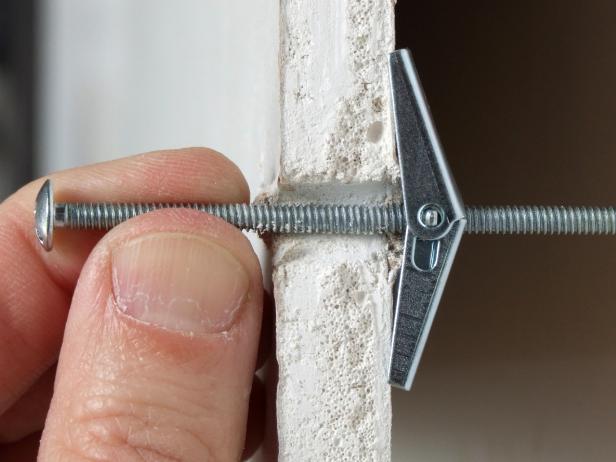
Chris Hill
Toggle Bolt
Toggle bolts can easily be removed from a wall with minimal damage by using a drill to unscrew the bolt from the toggle. The toggle is spring-loaded, so it will not fold to fit back through the wall hole. Pull on the head of the bolt slightly to give the toggle some grip against the backside of the gypsum board. When the toggle frees from the bolt, you will hear the toggle fall between the space between the studs. The bolt is reusable if you get a new toggle for it.
Recess the Anchor (or Push It Through the Wall)
If the wall anchor can’t be pulled out with pliers or unscrewed from its hole with a counter-screw bit, do the opposite and push it in further.
If the head of the wall anchor is resting out of the wall, overlapping the paint, you’ll need to cut the head off. You may need to use a utility blade to carefully cut away the top layer of drywall that’s holding onto the lip of the anchor. A sharp blade is less damaging than ripping the anchor out of its hole. Plus, you will be filling the hole once the head of the anchor is out of the way. You may also be able to slice the edge off the anchor without cutting the drywall if the anchor is sticking out far enough. The utility blade is good for plastic anchors, but for metal anchors, you may need to use a cutting wheel attachment on a drill.
Once the anchor is no longer overlapping the drywall, put a small screwdriver into the hole and use a hammer to tap the end to push the wall anchor deeper. You may be able to drop it into the space behind the drywall (and depending on the type of anchor you’re recessing, parts of it may already fall back there). You can also leave the anchor recessed into the drywall so that it will be invisible once the hole is patched.

Shutterstock/Anna Jurkovska
Patch the Hole
Once the anchor is removed or recessed, you’ll have to patch the drywall. If any edges of the drywall around the hole are poking out, press them inwards or use the utility blade so that the area is flat and smooth.
Then, use a spackling knife to apply a layer of drywall compound. Use the flat edges of the knife to butter the compound into the hole. Be careful to not dig into the hole with the knife; when in doubt, keep your layer of drywall compound thick because it can easily be sanded when it is dry.
Let the compound dry overnight and run a piece of 220-grit sandpaper over the surface gently to leave the refinished surface smooth. Wipe away any dust with a cloth and touch up the paint on the wall.
How to Repair Drywall
A well-placed piece of art may be the quickest way to disguise a hole in drywall, but for a professional fix, follow our tips for a smooth, finished surface.







